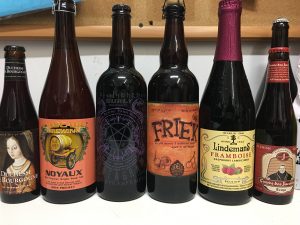Sour Beer!
- On April 24, 2018
Sours are the world’s first type of beer dating back to the mid-19th century. Why are they called sour? They have a tart, sour flavor that was first thought to be an infection in the beer. This was because of pre-modern sanitation and a lack of understanding of bacteria and wild yeast’s, specifically those called Lactobacillus, Pediococcus, and Brettanomyces, These yeast’s and bacteria are what gives it that tart and funky flavor.
To truly understand and fully appreciate sours, we must understand how different yeasts and bacteria affect beer. Brettanomyces (aka brett) which is a yeast, ferments at an extremely slow pace. Normal beers using the standard yeast called Saccharomyces, ferment within just a few days or a week. However, Brettanomyces can take weeks, months, or even years to fully develop the character its flavor due to its slow metabolism. The yeast eats the sugar and converts it into alcohol and then creates arrange in flavors from tropical and fruity to earthly and musty.
Lactobacillus is a bacteria that eats the sugars and coverts them into lactic acid (milk/butter acid) and not into alcohol. In turn this process lowers the acid level and adds that sour flavor to the beer. Lacto is used not only in beer but also in food fermentation like in kimchee and yogurt. You’ll experience this clean taste in German style sours like Gose’s and Berlner Weisse’s.
Pediococcus is also a bacteria that produces lactic acid and lowers the acid in beer. While lactobacillus is responsible for a cleaner and crisper sour flavor; Pedio produces more of a harsh flavor. It creates more of a funky aroma and flavor. It is used in conjunction with Brett to give it more fuel to work with. It eats the sugar and creates an even cleaner sugar for Brett to consume. At the end of the day Pedio is Brett’s workhorse. A great example of its flavor can be tasted in sours like Flanders reds and Lambics.
Sour beers all tend to get lumped into one category but as you can see there are many different factors that create lots of different styles of “sour”!



0 Comments